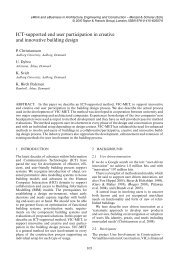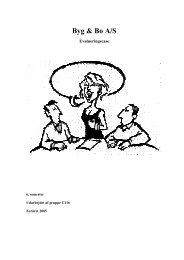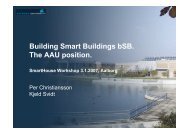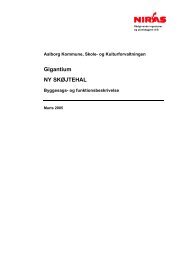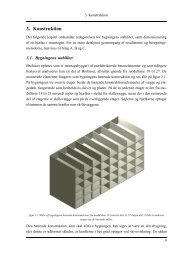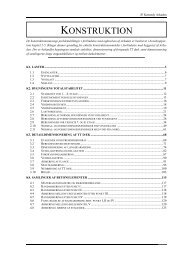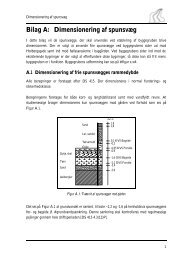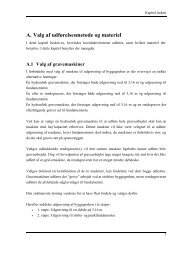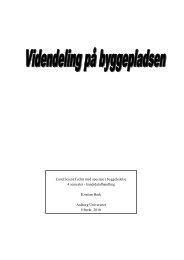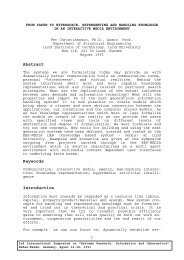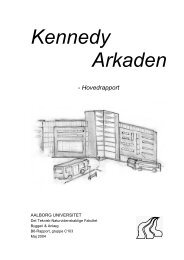[abs ID] PAPER TITLE - IT in Civil Engineering. Aalborg University
[abs ID] PAPER TITLE - IT in Civil Engineering. Aalborg University
[abs ID] PAPER TITLE - IT in Civil Engineering. Aalborg University
Create successful ePaper yourself
Turn your PDF publications into a flip-book with our unique Google optimized e-Paper software.
- human computer <strong>in</strong>teraction <strong>in</strong> Master of <strong>IT</strong>, MI, open education <strong>in</strong> Distributedsystems (a three year half time education with specializations <strong>in</strong> Build<strong>in</strong>g, Control,Real time systems, Production and Systems adm<strong>in</strong>istration. See alsohttp://it.civil.auc.dk/it/education/master_it_open/<strong>in</strong>dex.htmlhttp://www.mi.itorg.auc.dk/2 LEARNING CONTEXT. THE AALBORG EXPERIMENTThe learn<strong>in</strong>g process has not changed to any considerable degree dur<strong>in</strong>g the latest centuries.A big shift came when the art of pr<strong>in</strong>t<strong>in</strong>g was <strong>in</strong>troduced dur<strong>in</strong>g the middle 1400(Guthenberg) and it become practical and less expensive to pack and distribute <strong>in</strong>formation toa large audience.The PPBL, Project and Problem Based Learn<strong>in</strong>g, methodology was <strong>in</strong>troduced 1974 at<strong>Aalborg</strong> <strong>University</strong>. From (Kjersdam and Enemark 1994): "The curriculum <strong>in</strong> eng<strong>in</strong>eer<strong>in</strong>g aswell as <strong>in</strong> the natural science is project-organised from the day the freshmen arrive until theirgraduation. The first year the freshmen learn to work <strong>in</strong> project-groups. The next two years <strong>in</strong>the undergraduate programmes the project work is ma<strong>in</strong>ly design-oriented. The last two years<strong>in</strong> the graduate programmes the project work is ma<strong>in</strong>ly problem-oriented (Problem BasedLearn<strong>in</strong>g). ..... The duration of each project is one semester. In the programme half of thetime is distributed to the project work, 25% to courses related to the project and 25% tocourses related to the curriculum."The system is resource demand<strong>in</strong>g <strong>in</strong> office-space, supervision, constantly changed orrenewed lecture contents due to high adaptability to <strong>University</strong> external and <strong>in</strong>ternaldemands. But it is also an effective model. 80% of the students pass their exam<strong>in</strong>ation at theprescribed time.<strong>IT</strong>-supported open MSc education has been run s<strong>in</strong>ce 1991 at <strong>Aalborg</strong> <strong>University</strong>. Theproject/problem based learn<strong>in</strong>g pedagogic method is reported to strongly support new ideason life long learn<strong>in</strong>g, (Bygholm and Dirck<strong>in</strong>ck-Holmfeld 1997). The same authors also reportthat it is very favourable to start the education with a (partly guided) pilot project for thestudents to get acqua<strong>in</strong>ted with new ways of work<strong>in</strong>g and collaboration, project groupform<strong>in</strong>g, us<strong>in</strong>g new <strong>IT</strong>-tools etc. It is also important that a pedagogical dramaturgy is def<strong>in</strong>edto support positive experiences and engagements to avoid student emotional block<strong>in</strong>g.Dramaturgy is closely l<strong>in</strong>ked to user models support<strong>in</strong>g user action, roles, emotions,cognitive processes and language.PPBL will also provide the fundaments for a beneficial development of creative and criticalstudent th<strong>in</strong>k<strong>in</strong>g techniques as well co-operative and collaborative learn<strong>in</strong>g with WWWsupport, see (Bonk & Reynolds 1997). The prerequisites are there for the open m<strong>in</strong>dedcreative collection and exchange of ideas with<strong>in</strong> groups and with tutors, collaborativeproblem solv<strong>in</strong>g, reflection, evaluation, and efficient visualisation of the processes.The '<strong>IT</strong> Innovation at <strong>Aalborg</strong> <strong>University</strong>' project concentrates on the university applicationof <strong>in</strong>formation and communication technology <strong>in</strong> teach<strong>in</strong>g, research and adm<strong>in</strong>istration and is<strong>in</strong>tended to make visible and utilise the experiences already ga<strong>in</strong>ed by the departments of theuniversity and its students, see http://www.iti.auc.dk/English/. Other collaboration <strong>in</strong>itiativesare European <strong>University</strong> Network for Information Technology <strong>in</strong> Education (EUN<strong>IT</strong>E), andEuropean Consortium of Innovative Universities (ECIU) http://www.eciu.org/.
3 THE DISTRIBUTED LEARNING ENVIRONMENTS3.1 Def<strong>in</strong>itions and contextFirst let us make a def<strong>in</strong>ition (Christiansson, 1999)ÒDistributed learn<strong>in</strong>g takes place <strong>in</strong> a virtual learn<strong>in</strong>g space that expands theconventional study chamber and classroom <strong>in</strong> time and room with regard to learn<strong>in</strong>gstyle and <strong>in</strong>teraction modes as well as learn<strong>in</strong>g material and learn<strong>in</strong>g methodsÓ.Figure 1. <strong>IT</strong> tools (new and exist<strong>in</strong>g) will support collaboration and <strong>in</strong>formationaccess support <strong>in</strong> a distributed learn<strong>in</strong>g environment.Figure 1 provides a map for how <strong>IT</strong> can support communication <strong>in</strong> a distributed learn<strong>in</strong>genvironment. The learn<strong>in</strong>g activities goes on <strong>in</strong> rooms/spaces aimed for personal work, groupwork, lectures and whole course/class activities. <strong>IT</strong>-tools will support personalcommunication and provide communication support with educational artifacts. It should bepossible to- create personal, group, and course rooms/spaces (physical and virtual) as well associal meet<strong>in</strong>g places.- create work<strong>in</strong>g areas for the mentioned spaces- ensure communication bandwidth capacity and network functionality (QoS, Quality ofServices) for chosen <strong>in</strong>formation contents and communication requirements,
- provide access to physical and logically shielded nets from home, company,permanent/temporary university group workplaces- provide mechanisms for personal, methodological, course, and system developments(easy feed-back mechanisms, help functions as wizards/agents, self tests, transparentsystem structure, client computer platform <strong>in</strong>dependence, expandable and flexiblesystem, history record<strong>in</strong>g of document and software changes, version<strong>in</strong>g, etc.),- provide course, group and personal adm<strong>in</strong>istration functions (e.g. plann<strong>in</strong>g, calendar,external database connections).3.2 User models and learn<strong>in</strong>g stylesFigure 2. Computer systems explicitly or implicitly conta<strong>in</strong>s models of the userFrom Merriam Webster:Cognition = the act or process of know<strong>in</strong>g <strong>in</strong>clud<strong>in</strong>g both awareness and judgement;from co- + gnoscere to come to knowDifferent learner characteristics can be def<strong>in</strong>ed. From (Montgomery 1995)- Process<strong>in</strong>g (Active/Reflective)Active learners learn best by do<strong>in</strong>g someth<strong>in</strong>g physical with the <strong>in</strong>formation, whilereflective learners do the process<strong>in</strong>g <strong>in</strong> their heads.- Perception (Sens<strong>in</strong>g/Intuitive)Sensors prefer data and facts, <strong>in</strong>tuitors prefer theories and <strong>in</strong>terpretations of factual<strong>in</strong>formation.- Input (Visual/Verbal)Visual learners prefer charts, diagrams and pictures, while verbal learners prefer thespoken word- Understand<strong>in</strong>g (Sequential/Gloabal)Sequential learners make l<strong>in</strong>ear connections between <strong>in</strong>dividual steps easily. Whileglobal learners must get the "big picture" before the <strong>in</strong>dividual pieces fall <strong>in</strong>to place.
The results of the survey of student learn<strong>in</strong>g styles are also reported- 67%of the students learn best actively, yet lectures are typically passive;- 57%of the students are sensors, yet we teach them <strong>in</strong>tuitively;- 69%of the students are visual, yet lectures are primarily verbal;- 28%of the students are global, yet we seldom focus on the ``big picture.The example as expected emphasises that we have to harmonise the course material todifferent types of students m<strong>in</strong>ds and learn<strong>in</strong>g styles. Our possibilities to provide tools thatsuites different learn<strong>in</strong>g styles should be taken <strong>in</strong>to account as we develop ICT, Informationand Communication Technology, supported learn<strong>in</strong>g material. The user models are explicitlyor more often implicitly hidden <strong>in</strong> the computer system provid<strong>in</strong>g different pedagogicalapproach and human computer <strong>in</strong>teraction.3.3 Distributed learn<strong>in</strong>g systems. Basic functionalityA distributed learn<strong>in</strong>g environment must support a number of functions. As we set-up such anenvironment we can either try to f<strong>in</strong>d a complete system which fulfills our needs or ourselvesbuild a system from exist<strong>in</strong>g components, se figure 3.Before the start of the Master of <strong>IT</strong> education under the <strong>IT</strong>-Vest <strong>University</strong> <strong>in</strong> Denmarkdifferent systems to support distributed learn<strong>in</strong>g were <strong>in</strong>vestigated such as WebCT(http://homebrew.cs.ubc.ca/webct/), Lotus Notes (http://www.lotus.com, FirstClass (used fora long time at the <strong>Aalborg</strong> <strong>University</strong>) (http://www.softarc.com/), and the LUV<strong>IT</strong> systemdeveloped at Lund <strong>University</strong> <strong>in</strong> Sweden. http://www.luvit.com/. The choice fell on LUV<strong>IT</strong>though it was not specially geared towards group collaboration <strong>in</strong> project work.Below some general experiences from educational <strong>IT</strong>-support systems development and useare recorded, see also (Christiansson, 1999)- client competence to support requirements formulation is often low (both on <strong>IT</strong> andmethodological issues),- actively <strong>in</strong>volve end users <strong>in</strong> the requirements phase from the start of the project andonwards. Though be aware that non-l<strong>in</strong>ear th<strong>in</strong>k<strong>in</strong>g required for hypermedia design aswell as knowledge on the <strong>in</strong>fluences of new <strong>IT</strong>-tools on learn<strong>in</strong>g methods usually areunder developed (use learn<strong>in</strong>g by do<strong>in</strong>g and best practice dissem<strong>in</strong>ation),- follow up costs is often underestimated (e.g. new skills needed, change of work<strong>in</strong>gmethods and organisation structures, server ma<strong>in</strong>tenance, long term course materialand student documents storage),- strive for client computer platform <strong>in</strong>dependence (Mac, PC and Unix). Today possiblethrough use of WWW and Java Virtual Mach<strong>in</strong>es,- it may be necessary to differentiate between video (ISDN) and shared workspace(TCP/IP) physical communication channels . TCP/IP today best handles sound andstill images only,- be aware of the very different requirements posed by learn<strong>in</strong>g context, pedagogicalmethods and knowledge content,- create four user levels for the learn<strong>in</strong>g environment - students, teachers, courseadm<strong>in</strong>istrator, system,
Figure 3. Ma<strong>in</strong> services <strong>in</strong> the distributed learn<strong>in</strong>g environment.- course material should typically support self study and tests, lectures, <strong>in</strong>dividual andgroup exercises, project work, and social contacts,- teacher HTML knowledge is required for optimal course development performance(high level WYSIWYG HTML editors are not good enough),- student HTML knowledge is required to make project webs (not enough with copypastefrom good examples on the WWW),- system adm<strong>in</strong>istration doma<strong>in</strong>s are typically - student personal, student group, teacher,teacher group, department, university <strong>in</strong>ternal and university external,- be open for us<strong>in</strong>g English <strong>in</strong>stead of your national language,- create good user feed-back facilities,- system availability must be100%.4 EXPERIENCES FROM DISTRIBUTED <strong>IT</strong> SUPPORTED LEARNING4.1 Communication, project work, and virtual classroomIn the Master of <strong>IT</strong>, MI, course students are situated at different places <strong>in</strong> Denmark and meet<strong>in</strong> person at <strong>Aalborg</strong> <strong>University</strong> every six week at a weekend sem<strong>in</strong>ar for deeper socialcontacts, personal contact with course tutors, collective questions answer<strong>in</strong>g, guest lectures,group works, and f<strong>in</strong>al exam<strong>in</strong>es. New learn<strong>in</strong>g <strong>IT</strong> tools are <strong>in</strong>troduced to support self-study,project work, self-assessments, project delivery, communication and course adm<strong>in</strong>istration.
Experiences are reported earlier <strong>in</strong> (Christiansson, 1999) for example concern<strong>in</strong>g remoteteacher - student group <strong>in</strong>teraction. In one case two parallel communication channels wereused namely ISDN based video and shared application over Internet. Some experiencesconcern<strong>in</strong>g collaborative work from this and earlier activities at KBS-Media Lab at Lund<strong>University</strong> are,- video/sound connection over Internet, e.g. over a CuSeeMe reflector (Mod<strong>in</strong> 1995) isonly adequate us<strong>in</strong>g very low image update,- very good social connection may be achieved with the teacher/coach who thoughwished to have better eye and body language contact with the students (video camerascan be controlled remotely and should be pre-set at different positions),- shared applications work very well both for collaborative production work andcreative sketch<strong>in</strong>g (Timbuktu from Farallon Comput<strong>in</strong>g Inc. and Netmeet<strong>in</strong>g fromMicrosoft Corp.)When group communication takes place outside the <strong>University</strong> and the students sit at home orat their companies (as is sometimes the case <strong>in</strong> the MI education) high quality synchrounousmultimedia communication is harder to achieve due to bandwidth limitations. Email is usedextensively with references made to documents and project works at group project webs. Thecommunications with teachers/tutors are also done with email. Some tutors (mostly aslisteners) participate <strong>in</strong> the group communication. Some project work are preferably done atthe weekend sem<strong>in</strong>ars, typically conceptual system modell<strong>in</strong>g , creative design, jobschedul<strong>in</strong>g and overall time plann<strong>in</strong>g.Learners demand on communication is on- efficient navigation <strong>in</strong> the learn<strong>in</strong>g material (available on Internet and sometimes CD)- distributed group communication (messag<strong>in</strong>g, direct communication, anddocumentation of communication)- possibility to flexible project web access (possibly protected)- bandwidth (strongly <strong>in</strong>fluences group collaboration)4.2 Student view on learn<strong>in</strong>g materialThe coarse material accessible from the education web consists of- education and courses descriptions- weekend sem<strong>in</strong>ar contents (if applicable for the education)- lecture notes- books and paper references- papers and other course material- exercises- self assessment tools- evaluation formsIn the MI courses the student group have access to separate servers for implementation andtest of for example web-database application developments with applet-servlet technique toprevent fatal errors on education servers.
Figure 4. MI students have access to a protected course material server and separate exerciseweb servers. Student communication is mostly done via email and to some extent via chatand Internet video/application shar<strong>in</strong>g (Netmeet<strong>in</strong>g).Project webs are <strong>in</strong>creas<strong>in</strong>gly used also <strong>in</strong> the <strong>University</strong> located courses. The project webstypically conta<strong>in</strong>s project group member presentations, project descriptions, cont<strong>in</strong>uos projectdocumentation and collaboration material, time plans and schedules, l<strong>in</strong>ks and references toproject resources and results, exercises results, and communication documentation (chats,emails etc.)Figure 5 shows a typical example on lecture notes <strong>in</strong> this case from one of the courses,Human Computer Interaction, HCI, <strong>in</strong> the MI education.4.3 Teacher view to systemThe distributed <strong>IT</strong>-supported learn<strong>in</strong>g environment poses new challenges to teachers <strong>in</strong>develop<strong>in</strong>g new courses and re-eng<strong>in</strong>eer<strong>in</strong>g old. New work<strong>in</strong>g methods are <strong>in</strong>troduced as wellas new rout<strong>in</strong>es for course ma<strong>in</strong>tenance, changes <strong>in</strong> learn<strong>in</strong>g methods and pedagogics, anddevelopment of efficient collaboration with<strong>in</strong> and between universities.It is tempt<strong>in</strong>g to create a web of learn<strong>in</strong>g material that cont<strong>in</strong>uously is improved based onupdates of a only low level <strong>in</strong>formation chunks. Ord<strong>in</strong>ary books forms a self conta<strong>in</strong>ed unitwhere presentation and storage medium is static and as a whole revised to new versions(editions). Figure 6 <strong>in</strong>dicates that a teacher can create chunks of general slides and learn<strong>in</strong>gmaterial that <strong>in</strong>dependently can be updated and together form/l<strong>in</strong>k to a dynamic 'book'/coursematerial (the CN node).
Figure 5. Lecture notes are organized with course specific 'content' page, exercises,references and scheme. The 'slides' are picked via l<strong>in</strong>k from a slide repository.My personal view is that it should be possible to trace the development of courses and thatlearn<strong>in</strong>g material should be dated to reflect what students learned at a certa<strong>in</strong> time, That is thecourse content and references should be ma<strong>in</strong>ta<strong>in</strong>ed <strong>in</strong> that year course edition. 'Slides' l<strong>in</strong>kedto lecture notes may though from efficiency demands be updated but could beside /latestupdate/, (previous update), [creation date] have <strong>in</strong>ternal date marks for updated content toreflect progression.It is important that each 'knowledge node' <strong>in</strong> an educational network has a responsible'publisher'. This may often lead to local storage of referenced material not produced at thepublisher site. That is a local copy of the document is stored on the course node, CN, toensure access even if the referenced orig<strong>in</strong>al is removed. Copyright issues must here becleared out.The new educational shells like LUV<strong>IT</strong> gives new possibilities to enhance courseadm<strong>in</strong>istration and to <strong>in</strong>troduce new services like documentation of student use of differentservices, and learn<strong>in</strong>g materials. The drawback is that a rather time consum<strong>in</strong>g up-load<strong>in</strong>g toeducation node (EN <strong>in</strong> figure 6) must be made each time a change is made <strong>in</strong> the teacherslocal course node repository (CN). If only l<strong>in</strong>ks to local CNs are stored <strong>in</strong> EN the distributedapproach is at hand.
Figure 6. Students ma<strong>in</strong> education access is through the Education Node, EN. If all traffic ischannelled through EN it is easier to create adm<strong>in</strong>istrative data as 'who-is-on' and 'when', and'who has accessed what'.In case of use <strong>in</strong> <strong>in</strong>experienced teacher's environments a tool like LUV<strong>IT</strong> has it's obviousadvantages to handle course material <strong>in</strong> a closed form. The QoS of such systems must thoughbe further improved.Curiously enough we have experienced many young students not to feel comfortable withus<strong>in</strong>g WWW based (computer stored) documents as a ma<strong>in</strong> source of course material and asource to valuable <strong>in</strong>formation and further references. Also many teachers have difficulties toadopt to new additional (i.e. <strong>IT</strong>-supported) forms of tutor<strong>in</strong>g and project follow up.
5 CONCLUSIONSWe are only <strong>in</strong> the beg<strong>in</strong>n<strong>in</strong>g of development of cross-discipl<strong>in</strong>ary university courses <strong>in</strong> openenvironments with highly communicative <strong>IT</strong> tools <strong>in</strong> contrast to traditional classroomteach<strong>in</strong>g. <strong>IT</strong> supported distributed learn<strong>in</strong>g provides us with excellent possibilities to advancethe learn<strong>in</strong>g methodologies suitable for life long learn<strong>in</strong>g and to render exist<strong>in</strong>g courses moreeffective. There is a great need to raise the <strong>IT</strong> competence of the teachers to meet the needsfor and carry<strong>in</strong>g through of the changes <strong>in</strong> education on all levels. We will <strong>in</strong> the future see acloser natural collaboration between universities <strong>in</strong> course development, and experienceexchange.REFERENCESBonk C, Jay, Reynolds T H, 1997, "Learner-Centered Web Instruction for Higer-OrderTh<strong>in</strong>k<strong>in</strong>g, Teamwork and Apprenticeship". (pp. 167-168) <strong>in</strong> Web-Based Instruction. ed.Badrul H. Kahn. Educational Technology Publications. Englewood Cliffs, New Jrsey. (463pp.).Bygholm A, Dirck<strong>in</strong>ck-Holmfeld L, 1997,"P¾dagogik i det virtuelle l¾remilj¿ -metoder ogovervejelser" <strong>in</strong> L¾r<strong>in</strong>g og Multimedier, 1997. ed. Danielsen O. <strong>Aalborg</strong> Universitetsforlag.(pp. 63-86)Christiansson P., (1999) " Experiences from Design and Use of <strong>IT</strong> Supported DistributedLearn<strong>in</strong>g Environment". <strong>Civil</strong> Eng<strong>in</strong>eer<strong>in</strong>g Learn<strong>in</strong>g Technology <strong>in</strong> Cardiff. (edited by R MLloyd & C J Moore). Thomas Telford Ltd. London. (pp. 29-42). 3rd AECEF InternationalSymposium (Association of <strong>Civil</strong> Eng<strong>in</strong>eer<strong>in</strong>g Faculties with participation of civileng<strong>in</strong>eer<strong>in</strong>g faculties from non-European countries). CELTic 1999. 8-10 September 1999,Cardiff. http://it.civil.auc.dk/it/reports/r_cardiff_edu_1999.pdfChristiansson P, Herrera A, 1985. Datorstšd i Byggprocessen. Computer Aided Design.(Computer Aids <strong>in</strong> the Build<strong>in</strong>g Process. Cad Systems, Relational Databases, KnowledgeBased Systems). BŠrande Konstruktioner, Lunds Tekniska Hšgskola. Februari 1985. (192pp.).Kjersdam F., Enemark S., 1994, The <strong>Aalborg</strong> Experiment. Project Innovation <strong>in</strong> <strong>University</strong>Education. <strong>Aalborg</strong> <strong>University</strong> Press. (pp. 52).Mod<strong>in</strong> J, 1995, "COOCOM. New ways of us<strong>in</strong>g Information Technology for build<strong>in</strong>gs designand management". KBS-Media Lab, Lund <strong>University</strong>http://delphi.kstr.lth.se/reports/coocom1_6_1995.pdfMontgomery S. M., 1995, Address<strong>in</strong>g Diverse Learn<strong>in</strong>g Styles Through the Use ofMultimedia. <strong>University</strong> of Michigan.http://fairway.ecn.purdue.edu/v1/asee/fie95/3a2/3a22/3a22.htm. From the 1995 ASEE/IEEEFrontiers <strong>in</strong> Education 95 Conference http://fairway.ecn.purdue.edu/asee/fie95/Index.htm.


![[abs ID] PAPER TITLE - IT in Civil Engineering. Aalborg University](https://img.yumpu.com/51222254/1/500x640/abs-id-paper-title-it-in-civil-engineering-aalborg-university.jpg)
